Stay in the know on all smart updates of your favorite topics.
Amsterdam Donut Coalitie Meetup #5
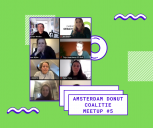
Op 15 april om 16.00 is het tijd voor de 5e online editie van de Amsterdam Donut Coalitie Meetup. Tijdens de online meetup delen we updates en leren we elkaar kennen. Je krijgt ook de kans om via break-out ruimtes dieper in te gaan op donut thema's (donut bedrijven, donut onderwijs, donut plekken, donut beleid en wetgeving etc). Wil je een steentje bijdragen aan de transitie naar een sociaal rechtvaardige en ecologisch veilige maatschappij? Meld je dan aan via de link.
AGENDA
16.00 Welkom & agenda
16.05 Wat is de Amsterdam Donut Coalitie
16.10 De donut in de gemeente Amsterdam | Salome Galjaard
16.20 Q&A met gemeente Amsterdam en community
16.35 Oproep via Scholars United for a Sustainable Amsterdam
16.40 Break-outs rond donut onderwijs & onderzoek + donut plekken
17.00 Recap Plenair
17.10 Einde
A comprehensive introduction into a human-centric approach of the smart city
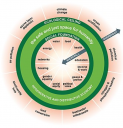
Recently, the peer-reviewed Journal of the Engineering and ˜Technology published an overview of the emergence of a human-centric approach into smart cities in contrast to the techno-centric approach. In this article I give many examples how technology can be applied as an enabler tp improve social and ecological sustainable city actions, starting from the principles of the donut-economy
Green Deal - mogelijkheid voor gemeenten om energietransitie, CO2 reductie en innovatie te stimuleren.

Frans Timmermans, Chef Klimaat van de Europese Commissie, lanceerde op 11 december de Europese Green Deal, het baanbrekende klimaatplan dat van Europa in 2050 het eerste klimaatneutrale continent in de wereld moet maken.
Met de Green Deal gaat Europa een ongekende uitdaging aan, die tegelijk ook nieuwe kansen biedt. Het eerste doel ligt al in 2030. Dan moet de CO2-uitstoot met 55 procent zijn teruggedrongen (versus 1990).
13 procent van het totale elektriciteitsgebruik schrijven we vandaag op het conto van verlichting – in 2006 was dat nog 19%. Met de totale omschakeling naar LED kan dat worden teruggebracht naar maar liefst 8 procent of bijna de helft in 2030. De missie moet dan ook zijn om LED-verlichting tot een algemeen goed en zelfs een verplichting te maken; niet alleen in de Benelux, maar ook zeker in Europa.
Ter illustratie: Als we vandaag zouden overgaan naar een totale ver-LED-ding van Europa, betekent dat over de periode 2006 – het jaar waarin werd opgeroepen om de gloeilamp wereldwijd uit te faseren – tot 2030 een besparing van 198 megaton aan CO2. Dat staat gelijk aan 267 elektriciteitscentrales of pakweg 50.000 (vijftig duizend!) windmolens.* De besparing voor Nederland alleen is 3,5 megaton aan CO2. Dat staat gelijk aan het elektriciteitsgebruik van drie miljoen huishoudens volgens de Nederlandse Licht Associatie en Fedet.**
Met de Green Deal ligt de weg open om de ver-LED-ding in Europa te versnellen. Dat is echt noodzakelijk en haalbaar: bijna 85 procent van alle lichtpunten in de Benelux kan nog vervangen worden door (connected) LED-lampen.
De voordelen voor gemeenten:
- Significante reductie van de CO2 uitstoot
- Energiebesparing
- Data gedreven onderhoud - transparant - veilig
- Veiligheid stad
- Toekomstbestendig - klaar voor digitalisatie
- Te integreren met een Smart City applicatie
- Eenvoudig beheer
Met het gebruik van de Green Deal kunnen gemeentes hen project laten subsideren als deze voldoet aan een aantal voorwaarden. Wij denken hier graag in mee.
Meer info over de Green Deal via de link.
Enquête (1min): Internationaliseren als MKB tijdens en na een crisis
Veel MKB-ers willen zich uit de crisis innoveren. Internationaal actief worden is kansrijk en vraagt voorbereiding en energie. Amsterdam Trade and Innovate en PIM Noord-Holland (Programma Investeringsgereed Innovatief MKB Noord-Holland) willen ondernemers helpen dit goed en succesvol aan te pakken. Ben jij een MKB-er in de MRA die actief is op de thema's van smartcity? Vul dan de enquête in zodat ons aanbod goed aansluit bij wat jij nodig hebt. Hou onze media in de gaten, in q1 organiseren we onze eerste event gericht op internationalisering.
CINDERELA living lab

From urine to plant 'food'
CINDERELA is a demonstration plant that transforms urine into nutrient-rich fertilizer. The plant is located at Marineterrein Amsterdam Living Lab (MALL), and consists of a refurbished shipping container – containing a laboratory and two urine-diverting toilets – and an adjacent greenhouse which also serves as a meeting space.
Visitors of the Marineterrein who use the toilets can witness how their urine is stabilized and purified in a bioreactor, and then distilled and concentrated into organic plant 'food'. At the demonstration plant, the urine is separated by the diverting toilets after which it is treated and 100% converted to usable raw material streams: nutrient-rich fertilizer and 'clean' water.
These two resulting products: the fertilizer – free of bad odor, pathogens or micropollutants – and water, will be used in the greenhouse and vegetable garden adjacent container, showcasing how nutrient-recovery technologies can be implemented to turn waste into resources and close the nutrient loop/create circular food systems.
Toilets that 'save' urine from the sewage system
So what actually makes urine a valuable organic waste stream? Its Nitrogen and Phosphorus content makes it a good fertilizer and compost accelerator. However, as you can imagine, it needs to be treated first to remove its bad odor and contaminants. In our innovative CINDERELA project, all available nutrients are recovered from urine.
In order to achieve this, a new type of toilet is used – developed by EAWAG, EOOS and LAUFEN – which looks just like a normal toilet. The only difference is that these toilets have an internal curved section that catches liquid on and around the bowl. By collecting the urine before it ends up in the sewage system, these toilets allow this waste stream to be re-purposed.
Separating urine before it ends up in the sewage systems is an effective recovery approach, as urine makes up roughly ~1.5% of the volume of sewage yet contains ~55% of its Phosphorus content and 80% of the Nitrogen (the two main nutrients needed for a fertilizer).
CINDERELA’s urine to fertilizer process is largely based on the “VUNA” process developed by scientists at EAWAG. “Aurin” is the resulting fertilizer commercialized by EAWAG’s spinoff “VUNA”.
Why is it important to recover nutrients from our wastewater?
Nitrogen and Phosphorus are among the nutrients which can be recovered from urine. These two nutrients together with other macro- and micronutrients are essential for plant growth and thus the production of our food.
However, the current model for managing these nutrients in our food cycle is out of balance and unsustainable. Modern agriculture relies heavily on the use of mineral/synthetic fertilizers as a source of nutrients. This is problematic because both the production and usage of these nutrients cause problems:
(1) production of mineral/synthetic fertilizers is dependent on fossil and mineral reserves. Nitrogen fertilizers are derived from the energy-intensive conversion of atmospheric nitrogen into ammonia (known as the Haber-Boshprocess). Phosphorus is obtained from the mining of phosphate rock reserves, which are finite and limited to a few locations around the globe.
(2) the intensive use of fertilizers is increasing (roughly doubling) the input of available nitrogen and phosphorus into natural ecosystems which has severe ecological consequences. The over availability of fertilizers used on fields ends up in our water systems. This causes eutrophication: a dense growth of plant life that can disrupt existing eco-systems.
Circular use of Nitrogen (N) and Phosphorus (P) (e.g. recycling the nutrients in our wastewater back to food production) is essential to, on the one hand, reduce our dependency on fossil and mineral reserves, and on the other avoid the negative ecological impact of “waste” nutrients ending up in the environment.
Closing the loops
The process of transforming urine into fertilizer in itself sounds innovative, we can imagine. On its own, this concept of recovering nutrients from urine is not new as there are several projects in place in which this is done. There are however a few reasons why our CINDERELA project is particularly innovative:
- Firstly, let's start of with the way the urine is collected in this project. In many cases, projects (can) only make use of urinals. The toilets available in this project can be used by anyone, which enables us to collect greater amounts of this waste stream, without the need to change user's habits.
- Secondly, many of the existing projects that focus on recovering nutrients from urine are limited to retrieving struvite (which contains phosphorus, and limited amounts of nitrogen). In this project, all available nutrients are retrieved. Adding to this, the residual water, after struvite recovery, is still water waste. At the CINDERELA demonstration plant, the full urine stream is treaded and reused. Plants and greens will be grown with the recovered nutrients as well as the water;
- Thirdly, at this living lab plastic is collected separately – according to type and quality – to be recycled using AM techniques. After washing and grinding this plastic, it is used in 3D printing to make components to build a customizable freestanding planted wall – a perfect spot for the plants and greens to grow.
- Last but not least, 'closing the loop' with regard to all the above: the CINDERELA living lab contributes to creating a local circular system as the entire loop of organic and inorganic waste streams is closed; from urine to fertilizer and water, from plastic to a plant-wall.
Larger project scope
This experiment is part of a larger European project that focuses on recycling resources and waste material in the construction center. The overall objective of CINDERELA is to unlock the potential for a resource-efficient urban and peri-urban construction sector by developing a new Circular Economy Business Model (CEBM) for use of secondary raw materials (SRM) produced from different waste streams – such as wastewater – within urban and peri-urban area. Read more about the project here.
Recycling, downcycling and the need for a circular economy
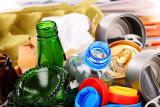
What happens to the plastic and paper that you’ve carefully sorted into separate bins?
Many of the products we recycle today are essentially downcycled. While this generally helps to preserve the life of raw materials and some of the value that went into creating them, there might be better ways to do it.
Find out more about the nuances between recycling, downcycling, and a truly circular economy, in this article.
Connect with a delegation of Belgian sustainable smart city startups

On 16/3 the City of Amsterdam will present its ambitions and achievements in smart mobility, smart buildings, energy transition and circular economy to a delegation of Belgian startups & scaleups.
We invite you to meet these startups in a digital meet & greet session (2-4PM), to find out what solutions they have to offer and how they can help your company, administration or institution to solve your sustainable smart city challenges.
Initiative of: StartupAmsterdam, Startups.be, Flanders Investment & Trade
Campus Amsterdam huiskamersessie Facility Sharing in de MRA #2

In oktober is Campus Amsterdam gestart met een oriëntatie van facility sharing in metropoolregio Amsterdam. Tijdens het verkennende onderzoek zijn diepte-interviews gehouden en is een huiskamersessie georganiseerd om tussentijdse bevindingen te toetsen. Hoewel de wens duidelijk bestaat om invulling te geven aan het concept facility sharing, ontbreken op dit moment de ingrediënten die nodig zijn om een breed gedragen platform te creëren. Waar wij echter weldegelijk kansen zien, is in het ontwikkelen van een blauwdruk voor facility sharing met casestudies die toepasbaar is voor organisaties met faciliteiten in metropoolregio Amsterdam.
Wat gaan we doen?
Ons doel is om een blauwdruk met stappenplan te creëren op basis waarvan geïnteresseerde partijen zelf vorm kunnen geven aan hun behoefte om faciliteiten te delen binnen een bepaalde sector of gebied. De blauwdruk wordt vrijelijk ter beschikking gesteld aan geïnteresseerde partijen. Daarnaast kan Campus Amsterdam desgewenst adviseren of als sparring-partner fungeren om de uitwerking vorm te geven.
Om de blauwdruk vorm te geven, halen we input op over de bovengenoemde succesfactoren en kijken we samen naar wat gebruikers minimaal nodig hebben om het toe te kunnen passen op hun eigen situatie of businessmodel.
Programma
- Welkom en presentatie Campus Amsterdam 2.0
- Presentatie bevindingen
- Interactieve sessie verdieping succesfactoren
- Interactieve sessie randvoorwaarden
- Afsluiting met roadmap
Meld je aan via deze link of stuur een bericht naar hello@campus.amsterdam.
Circular Innovation City Challenge

Do you have an innovative digital or data-driven solution that can help create a circular city? A city where businesses and people work together to make the most of our resources? An inclusive city, in which designing for circularity means providing new jobs and opportunities for all communities and citizens?
The Circular Innovation City Challenge is seeking early prototype to market-ready innovative solutions, with the potential to help create circular and thriving cities. Your solution can be cross-sector or focus on specific areas such as plastics, food, construction, textile, or others. It can focus on direct material reductions or on business and consumer behaviour. The most important thing is that your solution is digital or data-driven at its core, and responds to one or more of the innovation areas.
The challenge is a global call to action for innovators and entrepreneurs, businesses, and organisations. Challenge partners encourage all types of innovators globally to apply and help find the answers to create better and more circular cities.
The Circular Innovation City Challenge is made possible through the collaboration between the cities of Copenhagen, Glasgow, Amsterdam, New York, and Toronto, the Ellen MacArthur Foundation, and World Circular Economy Forum. The challenge is facilitated by the Danish Business Authority, the Danish Design Centre and Leaderlab.
Find out more about the challenge and submit your innovation no later than April 23rd 2021 via https://www.circularinnovation.city/
Metropolitan Mobility Podcast met Maurits van Hövell: van walkietalkies naar het Operationeel Mobiliteitscentrum

“Voorheen werd er gewoon rondgebeld: ‘Wij zitten in de instroom van de ArenA. We hebben nu 20.000 man binnen. Hoe gaat het bij jullie op straat?’” In de achtste aflevering van de serie A Radical Redesign for Amsterdam, spreken Carin ten Hage en Geert Kloppenburg met Maurits van Hövell (Johan Cruijff ArenA). Hoe houdt je een wijk met de drie grootste evenementenlocaties van het land, bereikbaar en veilig? Ze spreken elkaar in het Operationeel Mobiliteitscentrum over de rol van de stad Amsterdam, data delen en het houden van regie. A Radical Redesign for Amsterdam wordt gemaakt in opdracht van de Gemeente Amsterdam.
Luister de podcast hier: http://bit.ly/mvhovell
Seeking partnerships to mitigate restaurant packaging waste
Hello ASC community! We are a local start-up working to increase Conscious Dining through a new way of searching for and rating restaurants. It is also our goal to go beyond the digital by working on local impact projects.
Recently, we surveyed the 150+ restaurants in our database on the effects of Corona on their sustainability practices, specifically in regards to the increase in packaging waste brought on by takeaway/ delivery services, and published an article on our findings here: https://www.table-sage.com/content/articles/amsterdam/restaurants-need-support-to-continue-sustainability-efforts-during-covid-19
We would love to collaborate with larger players, either 1) in further quantifying these effects, and/ or 2) in helping restaurants move to ecopackaging on a wider scale. Are you or someone you know interested in partnering to make moves in this space? We have a team of 6-8 able to support; more about us can be seen on www.table-sage.com.
New mechanisms needed to tackle Dutch early-stage circular economy funding gap
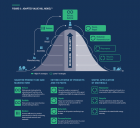
New research reveals a large funding gap for circular economy initiatives in the Netherlands, particularly early-stage circular ventures.
Interviews with city municipalities, entrepreneurs, financial institutions and working groups indicate that the funding gap is especially acute for higher value-yielding circular business models and activities such as reducing, reusing, repairing, and refurbishing.
Entrepreneurs in these areas of the circular economy struggle to find funding even though these activity types have the largest potential to increase the economy’s resource efficiency, and provide high-quality employment opportunities in cities. Research indicates that achieving a circular economy in the Netherlands could create approximately 200,000 new jobs by 2030.
The paper Financing Circular Economy Innovation in the Netherlands authored by Metabolic Institute with support from the Goldschmeding Foundation, highlights a lack of systemic collaboration as a critical barrier to circular innovation, and proposes new approaches to circular economy financing in the Netherlands.
“Blended finance instruments in particular can help to address circular economy related risks, and make the circular economy more investable for the private sector,”’ said Seadna Quigley, Lead Circular Finance at Metabolic.
Public-private collaboration in the form of blended finance works to de-risk circular asset classes by using public or philanthropic capital to stimulate the market, provide proof-of-concept, and draw private-sector capital into the circular economy.
“But lack of funding is not the only problem facing Dutch circular economy entrepreneurs,” said Liz Corbin, Director of Metabolic Institute. “They also lack access to experts and the necessary knowledge to navigate the funding landscape.”
To address current bottlenecks, the paper proposes the creation of a mission-driven investment fund and ‘innovation ecosystem’ that convenes impact investors, philanthropies, and city governments.
Numerous Dutch cities have impressive track records when it comes to circular economy plans, but access to finance is one of their most significant barriers to delivering on these plans.
In addition to systemic impact investing and fundraising, the fund will aim to create an enabling ecosystem that brings together capital, knowledge, and networks of expertise to provide entrepreneurs in the circular economy with the financial and non-financial resources they need to scale up their businesses.
“We believe that circular innovation and job opportunities are created by financing circular entrepreneurs. But financing alone is not enough; we have to build a support system for entrepreneurs on an urban level,” said Birgitta Kramer, Circular Economy Programme Manager at the Goldschmeding Foundation. “The 'Circular Innovation Ecosystem' is a first step towards guiding financiers, entrepreneurs and local governments to collaborate in this approach.”
A call to action
An impact- and mission- driven finance ecosystem has potential to accelerate the transition to a circular economy that equitably distributes prosperity to all and safeguards the natural world.
We invite the following stakeholders to collaborate with us to advance the development of such an ecosystem:
- Financier or investors with creative ideas and strategies for stimulating early-stage circular innovation in the Netherlands
- Asset owner or fund managers with the curiosity to develop and test impact-driven frameworks for portfolio management and evaluation
- Accelerators or incubators committed to supporting Dutch circular innovators and entrepreneurs
- Circular innovators or entrepreneurs interested in matching higher value circular solutions to the contexts and challenges of Dutch municipalities
- Municipalities looking for novel ways to deploy finance in service of circularity strategy
To learn more, please send an email to the CIE team at: circularfinance@metabolic.nl
Groen & Gezond Almere Podcast: Collectief bouwen aan de toekomst
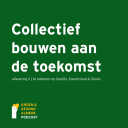
In de tweede aflevering van de Groen & Gezond Almere podcast, gaan we door op het thema circulaire economie. Dat onderwerp is ontzettend belangrijk in de stad, maar ook in de rest van het land: in 2050 wilt Nederland volledig circulair zijn ♻️
Onze stad groeit en daarmee lopen wij risico op een grondstoffentekort. De circulaire economie is populair onder het bedrijfsleven en de overheid, waar wordt gezocht naar manieren om anders te produceren en om te gaan met onze reststromen.
Ook in de bouwsector is dit thema terug te zien. In deze aflevering word je meegenomen in de uitdagingen én de kansen die er zijn op dit gebied. Net als in de vorige aflevering, spreekt Nadia Zerouali ook hier een Almeerder van de toekomst, student bouwkunde aan Windesheim Flevoland, Sander Verkade. Ze spreekt Raymond van Dalen & Pepijn van de Staak als ondernemers uit de sector die samenwerken in het Innovatief Bouw Collectief Flevoland. En, Arnout Sabbe spreekt zich uit als expert deze aflevering. Hij is onderzoeker bij de TU Delft en houdt zich dagelijks bezig met circulariteit in stedelijke gebieden voor AMS Institute.
Nieuwsgierig? Luisteren kan via Spotify, Soundcloud & iTunes. We zijn benieuwd naar wat je er van vindt! Laat je horen via onze social media: LinkedIn, Instagram, Facebook of Twitter
Ecodam, circulair economie education hub, is looking for partners and a location for a pilot lab

Ecodam is a young initiatief aimed at creating a place where young people will learn about and help build the circular economy. Ecodam is not highbrow and elitair but inclusive, hands-on, fun and accessible. We use design thinking principles, letting visitors operate as designers and makers. Thinking of new solutions for real problems and making new, circular, products.
Ecodam is currently looking for partners to help us realise our dream and a location for a pilot lab.
ideas and tips are welcome!
Robot maakt Johan Cruijff ArenA-balie van resthout
Studenten en onderzoekers van de HvA Robot Studio ontwikkelden voor Johan Cruijff ArenA een circulaire ontvangstbalie
'Binnenkort gaan we robots vragen om objecten te produceren uit resthout volgens onze ontwerpkeuzes', verklaart Marta Malé-Alemany, leider van de Robot Studio en hoofddocent Digitale productie aan de Hogeschool van Amsterdam (HvA). Samen met haar multidisciplinaire team (van architecten tot ingenieurs en tech-experts) en projectpartners onderzoekt de Digital Production Research Group (DPRG) hoe robots afvalhout kunnen verwerken tot nieuwe objecten. Het resultaat is een ontvangstbalie voor de Johan Cruijff ArenA. 'De eerste stap naar grootschalige en geautomatiseerde verwerking van resthout is gezet. ‘Deze aanpak biedt kansen voor de circulaire economie’, aldus Marta Malé-Alemany.
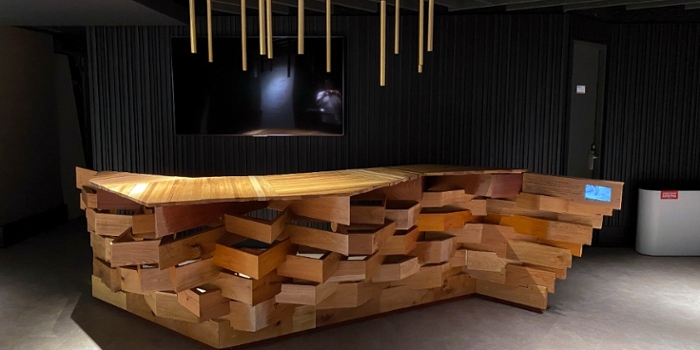
Fotocredits: Sander Heezen
Resthout is een complexe materiaalstroom, omdat het een gevarieerde verzameling overgebleven stukken hout is; grote, kleine, lichte, donkere en heel verschillende vezelpatronen. Bestaande technieken zijn niet geschikt om dit materiaal te bewerken, vanwege het ontbreken van standaardeigenschappen. Het komt dus neer op handmatig werk dat altijd (te) duur is. Gevolg: het materiaal belandt als afval in de open haard. 'Jammer, want het is nog steeds waardevol hout', zegt Malé-Alemany.
‘CONVERSATION-PIECE’
Alle reden voor de DPRG om bij de Robot Studio onderzoek te doen naar de verwerking van resthout door middel van computationeel ontwerp en robotproductie. Het eerste experiment was een loungestoel, gemaakt van hout verzameld bij afvalscheidingsstations. Een ‘conversation-piece' noemt Malé-Alemany het. 'Je hebt showcases zoals deze nodig om belanghebbenden te inspireren en het onderzoek verder te brengen.' Dat werd duidelijk toen Frank de Leeuw, coördinator duurzaamheid van de Johan Cruijff ArenA , de HvA bezocht: 'In de Robot Studio rook je bij binnenkomst gelijk de fijne geur van het resterend hardhout. We vonden het zo zonde om dit mooie materiaal te verbranden. De loungestoel liet ons de mogelijkheden zien van digitale productie om dit soort hout een nieuwe bestemming te geven. Voor ons: een circulair interieur in het stadion.'
ONTVANGSTBALIE IN DE SKYCLUB EN HOUSE OF LEGENDS
De Leeuw en zijn vaste leveranciers (ontwerpers en aannemers) besloten samen met de DPRG om een circulaire ontvangstbalie te creëren voor de nieuwe Level 6 Skyclub en House of Legends in het stadion. Antoine Pruyn, teamleider bij Heineken Interior Design: 'We ontwerpen op papier en wilden meer weten over deze technologie. We begrijpen de waarde van het materiaal en willen hergebruik bij onze klanten stimuleren.'
Voor interieurbouwer Nijboer was het een mooie kans om tegen een betaalbare prijs met high-end hardhout te gaan werken. Houthandel Amsterdamsche Fijnhout leverde het materiaal voor de balie; overgebleven stukken niet-verontreinigd hout van hoge kwaliteit, die overblijven na het zagen van grotere planken. Het zijn restanten hout die normaal als afval worden gezien en in de open haard verdwijnen. De DPRG ontwierp de balie samen met Lizzy Kroese, HvA-afstudeerder Product Design.
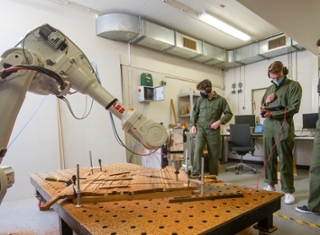
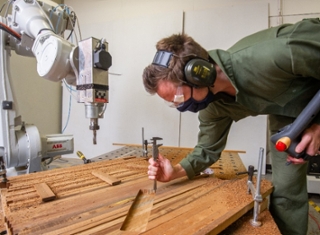
Fotocredits: Sander Heezen
ROBOTS AAN HET WERK
De opdracht was voor de HvA een uitgelezen kans om haar onderzoek naar digitale productie voort te zetten. 'De technologieën die we hebben geïntegreerd en ontwikkeld om de balie te produceren, zijn essentieel om grootschalige en geautomatiseerde verwerking van resthout mogelijk te maken', zegt Malé-Alemany trots. 'Het innovatieve aan onze aanpak is dat we technologieën zoals 3D-scannen en CNC (computergestuurd) frezen integreren in een continue workflow, met behulp van onze robots. Terwijl CNC-frezen vooral wordt gebruikt om vlakke oppervlakken te bewerken, kunnen robots deze techniek toepassen op objecten om elke gewenste vorm te creëren.'
MATERIAAL ALS UITGANGSPUNT
Malé-Alemany: 'Afvalmateriaal leidt hier een nieuw ontwerpproces. Vaak wordt eerst het ontwerp gemaakt en daarna pas gekeken naar het materiaal. In dit proces begint de robot met het 3D-scannen van de eigenschappen van het beschikbare resthout, zoals maat, vorm, kleur. De gegevens worden opgeslagen in een database en geïmporteerd in het 3D-ontwerp, dat zich aanpast aan het beschikbare hout. Zo ontstaan unieke objecten, afgestemd op de houtafmetingen en kenmerken. Zo werd voor de ontvangstbalie het hout gesorteerd op maat en kleur, wat zorgt voor een unieke baliestructuur en kleurverloop. Een proces dat met de hand te intensief en duur zou zijn.'
MEERDERE WAARDECREATIE
De ontvangstbalie in de Johan Cruijff ArenA is een bewijs dat het gebruik van robots voor materiaalhergebruik een nieuw en belangrijk potentieel voor de circulaire transitie is. Bovendien zijn de projectpartners tevreden met het resultaat en willen ze de ontwikkelde technologie verder implementeren. Malé-Alemany ziet het als het begin van een ontdekkingsreis: 'In de toekomst bepalen ontwerpers impactdoelen, in plaats van de vorm van een specifiek object; we krijgen meer algoritmen en robots, die ontwerpen kunnen genereren en produceren op basis van bestaande materialen; en wanneer we meer vanuit de waarde van allerlei (afval)materialen denken, kunnen we gemakkelijker duurzame objecten creëren om circulariteit te ondersteunen.’
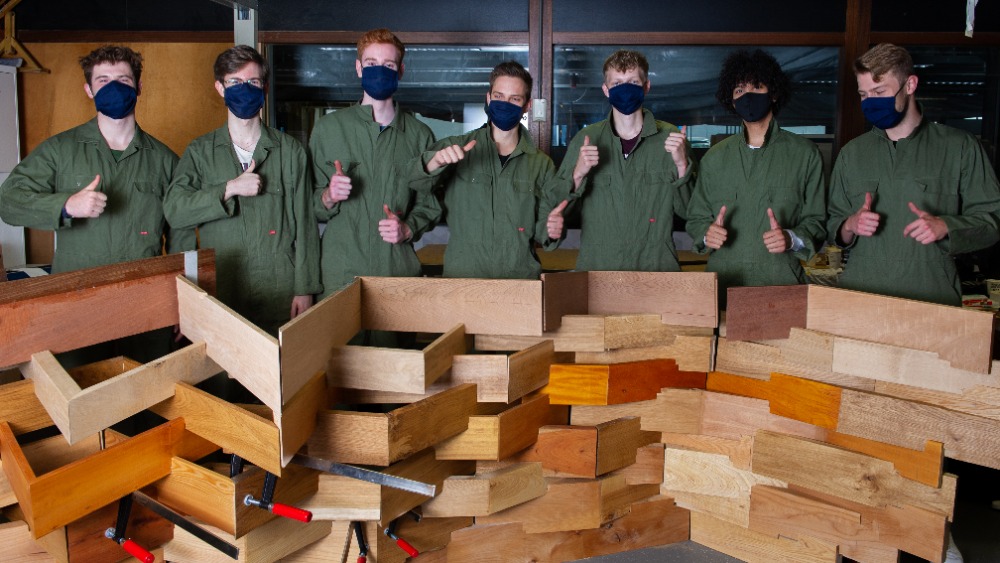
Fotocredits: Sander Heezen
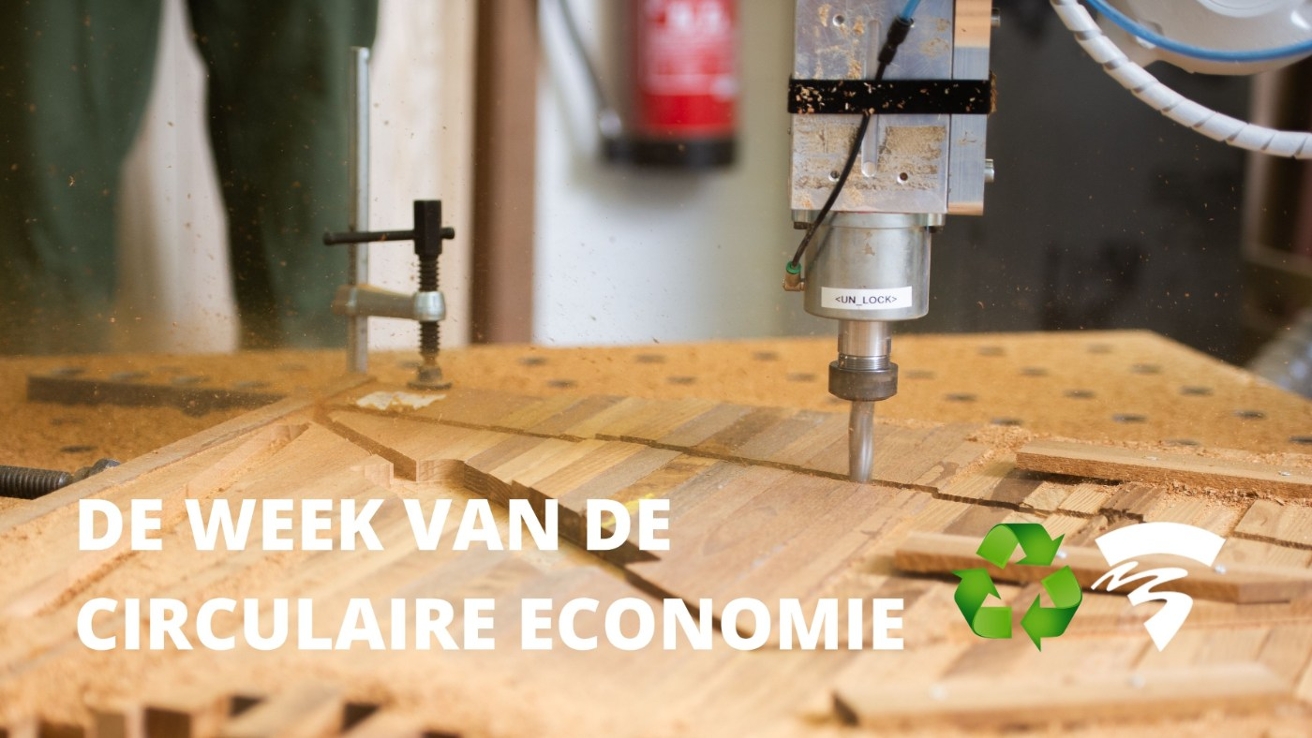
HvA & de Week van de Circulaire Economie
Hoe versnellen we de circulaire transitie? In het kader van de Week van de Circulaire Economie staan de Digital Production Research Group en het lectoraat Circulair ontwerpen en ondernemen van Centre of Expertise Urban Technology en Faculteit Techniek in het teken van een andere kijk op produceren én consumeren. Dagelijks licht de HvA onderzoeken, masterclasses en studentenprojecten uit die de transitie naar circulaire steden een boost geven.
Superleuke vacature bij Foodvalley!
Zin in een uitdagende baan waarbij je werkt aan een duurzaam voedselsysteem, samen met allerlei verschillende partijen? Dan is deze vacature misschien iets voor jou:
https://www.foodvalley.nl/vacancy/community-manager-the-protein-cluster-tpc/
Amsterdam: circulaire stad in 2050

Amsterdam: circulaire stad in 2050
Ondanks de coronacrisis zijn tal van bedrijven in regio Amsterdam bezig met circulaire projecten, business cases en onderzoeken. Net als de gemeente Amsterdam streven zij naar een circulaire stad in 2050.
Benieuwd? Bekijk de video Amsterdam: circulaire stad in 2050. Voor meer informatie kun je ook kijken op de CACR pagina of op amsterdam.nl/circulair.
Space for Food: Space technology for sustainable food systems on Earth
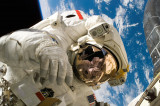
A big part of innovation in space technology revolves around finding smart, efficient and circular ways to establish a life support system for the astronauts going on the trip. Since it’s simply impossible to bring an end-less amount of resources on board, how do you make sure the astronauts can eat, drink and breath?
What if we view “cities as spaceships”; in terms of urban environments being ‘closed-loop systems’? This gives way to the idea that the same space technology developed by ESA could be applied to increase circularity in a city like Amsterdam.
Towards circular resource streams
Municipal wastewater is a great resource for nutrients and water reuse. The Space for Food project aims to use space technology in recovering nutrients and cleaning wastewater that can be used in food production using vertical farming. Closing the loops from waste to resource will help improving the impact in the environment, while creating resilience for the cities.
For this reason, the project will test a proof of concept using a raceway reactor for purple bacteria cultivation on brewery and municipal yellow wastewater at Marineterrein Amsterdam Living Lab. The biomass will be used as slow release fertilizer and bio-stimulant for cultivation of vegetables.
Accelerating circularity: monitoring tool geoFluxus helps cities turn company waste into value

Amsterdam 100% circular by 2050
The City of Amsterdam wants to be fully circular by 2050. That means that everything we use on a daily basis – from coffee cups to building materials – must consist of materials that have already had a previous life.
When it comes to household waste – this consists of, among others, vegetable, fruit and garden waste, paper, glass and textiles – the City has a duty to collect and process this. To give you an impression, the total household waste came down to about 380kg per year per person.
When comparing the amount of household versus company waste produced in the Amsterdam Metropolitan Area (AMA), still only 11% is household related, whereas 89% is company waste – such as sludge, scrap metals, wood and scrap lumber and very dedicated to the company processes related waste flows.
These company waste materials, as compared to consumer waste flows, often enter the waste flow in relatively good condition. This holds for instance for glass and wood, which are suitable for making window frames. If managed differently, these used materials in company 'waste' flows could be directly integrated at the start of the design process of new products.
So… How to boost the efficient re-use of company waste materials within the AMA?
geoFluxus: Turning data into comprehensible maps and graphs
With geoFluxus, incomprehensible waste data tables – including a.o. import and export and treatment methods – are converted into comprehensible maps and graphs. This is extremely valuable for spatial strategies in many other cities world-wide, and therefore TU Delft researchers Rusne Sileryte and Arnout Sabbe have founded the like-named spin off company geoFluxus, which has recently gone through a Arcadis City of 2030 Accelerator powered by Techstars.
Next to mapping waste, the geoFluxus team has connected open EU data on GHG emissions to the mapped waste flows by using transport, economic sector and waste treatment statistics. The resulting tool can provide governments with data evidence on what economic sectors, materials and locations hold the highest potential not only for waste reduction but also reductions of carbon emissions. Governments can use the tool to monitor progress towards circularity.
One company’s waste could be another one’s gain
The insights on the waste data generated by geoFluxus enable users to develop and test the impact of spatial strategies, for very specific locations, before actually implementing them. In addition, geoFluxus takes on a “match making” role: to have companies select company materials from other actors close by to re-use these instead of transporting the materials for waste treatment outside the AMA... Click on the link to read the full article >>
Kate Raworth en Inge Oskam in gesprek over de circulaire economie
Brits econoom Kate Raworth (HvA Professor of Practice), bekend van de Donuteconomie, en lector Circulair ontwerpen en ondernemen Inge Oskam (HvA Centre of Expertise Urban Technology) interviewen elkaar over de circulaire economie, Donutstad Amsterdam en systeemverandering op regionaal niveau. ‘We moeten multinationals in de grootste circulaire stad Amsterdam bij elkaar krijgen en vragen: wil je bij de stad blijven horen, hoe ga je dan bijdragen aan onze circulaire doelstellingen? Amsterdam kan de éérste stad te zijn die dit doet. Meer zullen volgen.’
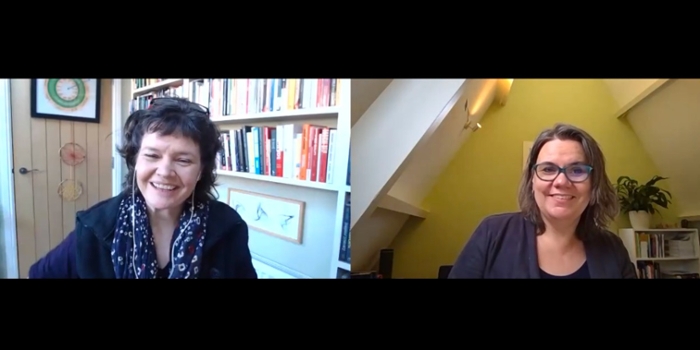
KR: Nederland heeft hoge ambities: In 2030 de helft minder verbruik van grondstoffen, in 2050 moeten jullie volledig circulair zijn (Grondstoffenakkoord van 2017). In hoeverre drijven deze kaders en grenzen innovatie in Amsterdam?
IO: Ik zie het akkoord en de doelstellingen als heilige graal, waar de organisaties die eraan meedoen motivatie en ambitie uit putten. 180 partijen ondertekenden het Grondstoffenakkoord. Van kennisinstellingen tot gemeenten en particuliere bedrijven. De regering en gemeenten namen het akkoord over als beleid, bedrijven en ondernemers als doelstelling. Alle stakeholders voelden de noodzaak om deze richting op te gaan.
KR: Ik ken geen ander land die circulaire ambities zo integreert in beleid als Nederland.
IO: Dat heeft denk ik te maken met ons welbekende ‘poldermodel’; we willen vaak rekening houden met iedereen. Daarnaast hebben we in Nederland een grote creatieve industrie die kundig is in het schetsen van toekomstscenario's, altijd met inachtneming van duurzaamheid. Dat zit in ons dna, kun je misschien wel zeggen. Die Nederlandse mentaliteit en het gedeelde begrip zorgen er volgens mij voor dat we collectief ons best willen doen. En dat terwijl niemand echt weet wat de circulaire economie en een afvalloos 2050 omvat.
KR: Ook weinig mensen weten goed uit te leggen wat de Donuteconomie inhoudt, haha. Het is een model dat door verschillende organisaties omarmd wordt, maar waar vaak nog concrete invulling aan gegeven moet worden.
Kate Raworth beschrijft in haar boek 'Donuteconomie' een economisch model waarin de ecologische grenzen van de aarde worden gerespecteerd. Zij gebruikt een donut om de balans tussen sociale voorspoed van mensen (de binnenste ring) en het tegengaan van aantasting van het klimaat (de buitenste ring) weer te geven. Voor het welzijn van mens en natuur is het belangrijk dat de juiste balans (de donut) wordt gevonden. In samenwerking met de gemeente Amsterdam ontwikkelde zij de Stadsdonut voor Amsterdam. Hierin wordt de stad bekeken vanuit vier perspectieven: sociaal, ecologisch, lokaal en mondiaal.
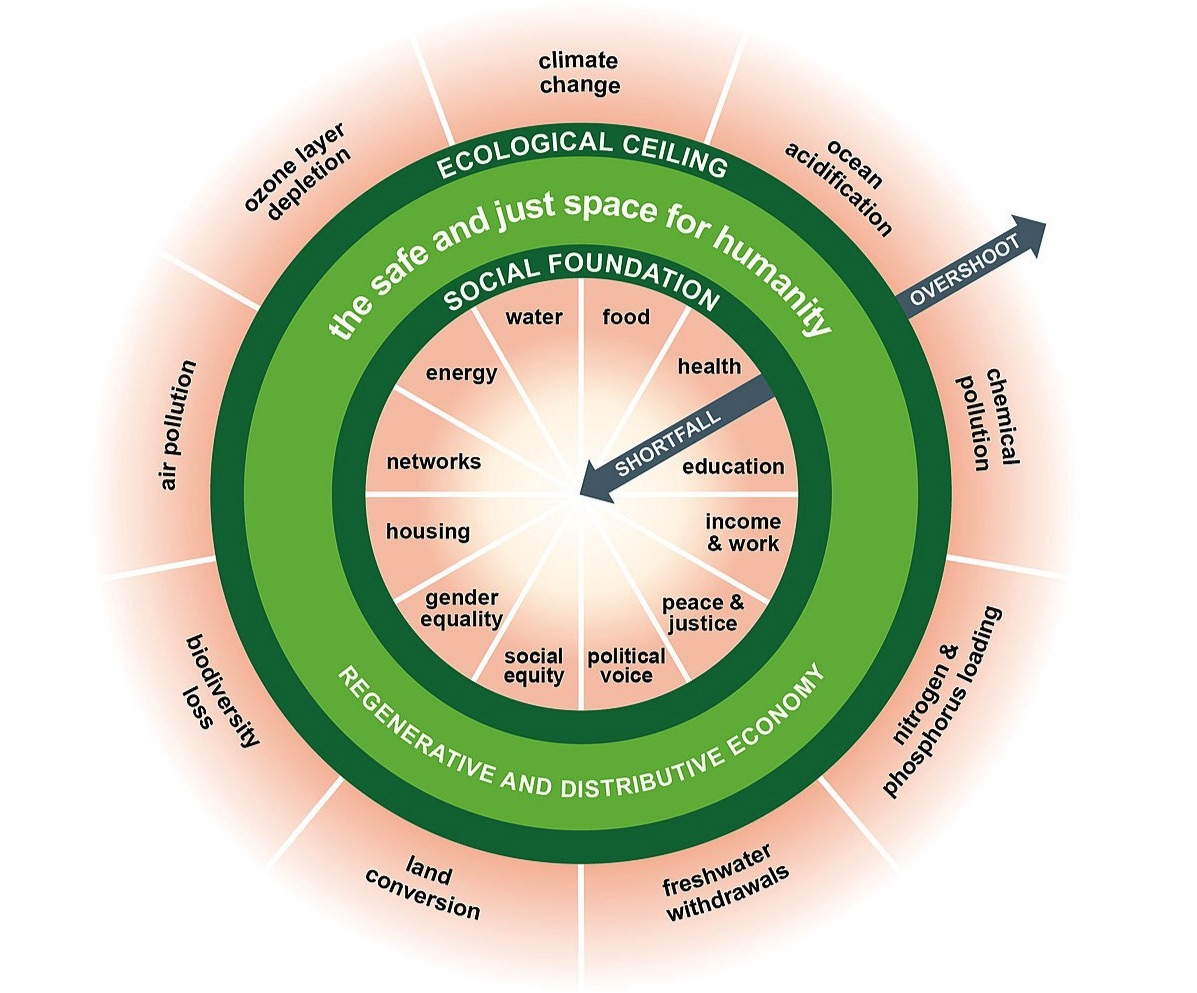
IO: Maar het Donutmodel biedt wel handvatten voor de transitie naar een circulaire economie. Het helpt je te kijken naar álle waarden die binnen een circulaire economie belangrijk zijn: zowel ecologische als economische en sociale waarde. Dat laatste wordt nog wel eens vergeten. Waar het Nederlandse beleid focust op materialen, gebouwen, infrastructuur, combineert gemeente Amsterdam, met haar Stadsdonut voor Amsterdam, dat met de sociale waarden; het gehele systeem. Zij betrekken alle stakeholders die daarvoor nodig zijn.
Wat voor mogelijkheden zie jij voor de circulaire economie op regionaal- of stadsniveau, zoals de toepassing van Stadsdonut voor Amsterdam?
KR: Amsterdam heeft een enorm bereik en vele mogelijkheden. Kijken we naar de multinationals, dan willen ze allemaal een winkel in Amsterdam hebben. Van Zara tot Apple. En als stad met een duidelijke circulaire strategie, indrukwekkende regelgeving en integriteit, dan denk ik dat je sneller een open gesprek kan voeren met de grote merken in de belangrijkste winkelstraten. Nodig de multinationals uit, wijs ze op het Grondstoffenakkoord en vraag ze hoe zij denken bij te dragen aan het collectieve belang. Hoeveel kleding of elektronica verkoop je, waar gaat het plastic heen, wat doe je met reststromen?
Ik heb het vaak over twee verschillende visies van circulariteit die zich kunnen voordoen. Een is wat ik noem siloed circularity, waarin individuele bedrijven zelf de producten of materialen terugnemen, repareren en hergebruiken. Dan houd je een gesloten kringloop, waarin bestuur en productie uitsluitend intern opereren. De ander is een circulair ecosysteem, een transparante markt met gezamenlijke waarden. Waarin we onderling data delen over wat voor materialen er zijn, waar die zich bevinden, wat er binnenkomt en uitgaat. Het verschil zit dus in de structuur: intern handelen tegenover een samenwerkend ecosysteem. Amsterdam, als eerste stad met duidelijk gedocumenteerde circulaire ambities, heeft de kracht om competitieve bedrijven bij elkaar te krijgen om richting een circulair ecosysteem te bewegen.
Maar één stad alleen gaat niet dé reden zijn om circulaire doelstellingen door te zetten in de honderden andere steden waar zij hun winkel hebben staan. Maar, je gaat wel de éérste stad zijn die deze vraag stelt. En als ze slim zijn, dan weten ze dat andere steden er ook naar gaan vragen.
IO: In Nederland zijn we net begonnen met het voeren van deze gesprekken met en tussen de bedrijven. En alhoewel ons nationale beleid een goede ontwikkeling is, denk ik dat de regelgevingen soms ook in de weg staan. Er is onderzoek gaande tussen steden om inzichten te krijgen in wat voor regelgeving beperkend werkt, denk aan bepaalde grondstoffen of materialen die een officieel label ‘afval’ krijgen waardoor je het niet meer als bron mag gebruiken, en hoe de huidige regelgeving zo aan te passen dat het juist stimuleert. Het zit nu nog soms samenwerking en daarmee algehele systeemverandering in de weg. We zitten echt nog in de voorontwikkelingsfase van de circulaire transitie.
KR: Vertel eens, van wat voor circulaire initiatieven in jouw omgeving word jij enthousiast en waar liggen kansen?
Ik zie kansen in overstappen van producteigendom naar materiaaleigendom binnen de circulaire economie. Een shift van siloed circulairty-bedrijven die hun eigen gemaakte producten terugnemen en daar nieuwe producten van maken, met de kans dat bepaalde materialen verloren gaan; naar specialistische bedrijven die nadenken over de levenscyclus van een materiaal en de meerdere toepassingsmogelijkheden in de cyclus. Dat creëert nieuwe businessmodellen en compleet nieuwe bedrijven. Zij moeten samenwerkingsverbanden aangaan met een variëteit aan producenten door ze als het ware materialen te leasen.
KR: Met wat voor materialen zie je dit de komende jaren gebeuren?
IO: Begin met materialen die erg schaars zijn. En materialen waarmee de waarde behouden kan worden, zoals hout en metaal. Materialen die meerdere levens kunnen hebben en waarvoor minder werk nodig is om dat te realiseren.
Daarnaast word ik enthousiast van de groeiende hoeveelheid initiatieven van ontwerpers en kunstenaars die nieuwe dingen maken van gebruikte materialen. En de nieuwe manieren waarop verkooppunten deze producten op de markt kunnen brengen. Hun verhalen vind ik interessant en zijn essentieel voor de transitie naar een circulaire economie. Ze kunnen iets vertellen over de herkomst van het nieuwe product. Dat creëert bewustzijn over de waarde van afval bij consumenten. Betrek daarom de burgers en consumenten, zij moeten andere producten willen en daar naar vragen. Maak ze onderdeel van de circulaire doelstellingen van de stad, bedrijven en andere organisaties.
KR: Gerelateerd aan verhalen over hergebruikte producten, denk ik ook dat de circulaire economie een zeer creatieve kan zijn. Kijk naar de vele restaurants of koffiezaakjes die vroeger een fietsenwinkel waren, mensen houden van nieuwe bestemmingen voor afgedankte maar waardevolle producten en materialen. De witty ways waarop ze de herkenbare, historische lagen in de nieuwe zaak zichtbaar houden, zoals een oude houtstructuur of fietselementen. Net als een oud kledingstuk van je moeder waarvan jij een rok hebt gemaakt. We houden van die speelsheid en verhalen. Daar liggen kansen!
Ik word nu met name enthousiast om in Amsterdam een ‘Dialogue Day’ te beginnen! Breng alle grote bedrijven bij elkaar, van supermarkten tot kledingwinkels. We heten je welkom in onze stad met een winkel, maar vertel: wat ga jij doen om kracht achter de circulaire transitie en onze doelstellingen te zetten, zodat je bij de stad kan blijven horen? Ik denk dat dat een zeer krachtige boodschap is.
IO: Ik denk dat het heel interessant is om dat met meerdere steden samen te doen, die bijvoorbeeld ook het Donutmodel gebruiken.
KR: Topidee! Ik wil graag hun verhalen horen. Dus breng internationale bedrijven in die steden samen om in gesprek te gaan over wat zij gaan bijdragen. Hoe zij willen ‘transformeren’ om onderdeel uit te maken van onze collectieve circulaire reis. Van Amsterdam tot Kopenhagen, Brussel, Nanaimo, Californië. Zij beginnen net met ontzettend mooie initiatieven.
IO: Dat zou fantastisch zijn. Laten we uitzoeken hoe we dat kunnen realiseren!

HvA & de Week van de Circulaire Economie
Hoe versnellen we de circulaire transitie? In het kader van de Week van de Circulaire Economie staan lectoraat Circulair ontwerpen en ondernemen en de Digital Production Research Group van Centre of Expertise Urban Technology en Faculteit Techniek in het teken van een andere kijk op produceren én consumeren. Dagelijks licht de HvA onderzoeken, masterclasses en studentenprojecten uit die de transitie naar circulaire steden een boost geven.
Stay up to date
Get notified about new updates, opportunities or events that match your interests.

